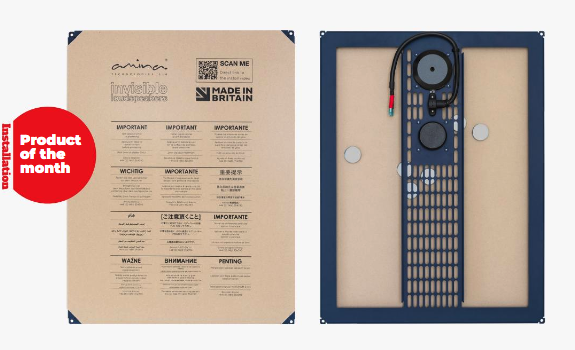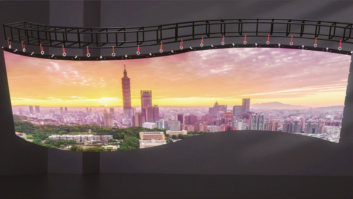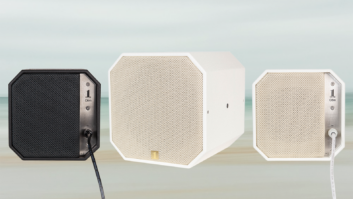
It’s…a new line up of invisible speakers.
What’s new? The line builds on the Mobius series launched three years ago, but the i series also represents a further leap in acoustic efficiency and improved overall acoustic performance.
Details: The company’s press event introducing the new range was hosted at the new Tateside experience centre in East London, with presentations and demos illustrating the advancements of the i series.
Continued research into driver technology, with significant advances made possible by simulation in the virtual domain, have allowed Neodymium (an increasing rare and expensive element) to be saved by creating novel geometries, yet improving the performance of the finished loudspeaker. That research has resulted in the company’s second generation Excelsior class high frequency driver, which the new Mobius i Series is based around.
The upshot is a massive 6dB boost in mid-range sensitivity, an extended lower frequency boost and increased smoothness and extension in the high frequencies. Both the mid-price Mobius5i and flagship Mobius7i boost high frequency reproduction above 30KHz. Everything combined, the overall result is an even more open sound with increased presence.
The company also stressed that invisible sound no longer implies a compromise on quality. Designers and architects can now have both excellent high clarity room filling sound with zero visual impact.
Available: Now

The history of Amina
During the press event, founder Richard Newlove detailed the origins of the company, which started back in 1997. Newlove was leading one of the original teams within the NXT group to develop and productionise the very first commercial products to utilise the then brand new Distributed Mode Loudspeaker technology. The basic principle of DML being the use of a sound board mechanism from the musical instrument, driven by an electro-magnetic device to set up its vibrations, rather than the strings for a violin for example.
Newlove recalls: “Those early products were incredibly crude. There were very few available composite materials that were suitable and cost effective enough for the price points required within the group brands. The first drivers had very limited power handling capabilities and generally the technology was unproven.
“Internally though, with all the research and practical applications we got involved with, we knew the technology really did work, and we knew that acoustically, a distributed, diffuse sound source (today we tend to call this spread source) had really positive benefits over the conventional point source, especially in large reverberant spaces. This was born out in practice time and again as we toured the country explaining the technology to the trade and making demonstrations in a variety of buildings from Churches to an enormous multi-storey glass atrium, and even Parliament. We also knew that these benefits extended to great handling of close proximity microphones, in applications such as roving radio mics and video conference systems, where feedback is reduced and gain can be lifted.”
At that time Newlove saw an opportunity to create great acoustically performing products practically disguised as something else, principally for the commercial marketplace. Meeting spaces, boardrooms, hospitality and worship areas etc. A big part of the key was to design audio technology products that suited the design environment, in fact, almost melted into it, rather than being aesthetically dominant as was usually the case in the past.
With the help of a trade partner in the UK, Newlove took a licence from NXT and established Amina, designing and manufacturing in the UK for the local and European commercially oriented customer base. The company commenced trading in May 1999.
Even though the licence was not exclusive and, at the time, NXT were signing up literally hundreds of similarly non-exclusive licences, we believed we had a chance to make a difference, as we would make custom parts, aesthetically different for every environment. Something that volume producers would not be interested in.
“Whilst the NXT Company folded many years ago now, I am incredibly proud of the dedicated team of people who have persisted in the determined development of this great technology and allowed Amina to cultivate that original dream into a company that has successfully carved a niche within the consumer electronics and AV industries,” comments Newlove. “That goal of creating great sounding audio products that have beneficial application in normally difficult spaces, and which integrate into the design aesthetic has been upheld and guides all we do.”
The invention of the original ‘invisible’ or plastered over loudspeaker came in early 2001. A German architect working on new bank headquarters for Bohn and Berlin wanted to use the company’s products. However his minimalist style demanded that absolutely nothing was to be seen. Even though he could set the 35mm deep module in the wall and paint it the same colour as the wall, he did not want to see the shadow gap. Newlove explains: “We came to an agreement to go away, design a product that actually could be skimmed over entirely. If it worked, he would pay us. If not, we would walk away empty handed.”
The product delighted the customer, and a new line of inherently invisible products was born.
As the product developed so did the custom integration market and in 2005 the company began to develop residential market channels in addition to its original commercial oriented channels.
Today the company invests more than ever in research and development to keep refining the performance of its invisible loudspeakers while broadening the speaker’s appeal in wider markets. This, while trying to make more efficient use of materials such as those rare earth elements used to create the high power driver magnets, the same materials that will be used in enormous quantities as the electric vehicle market develops.







